#Crystal Worl
Text

Salmon Boys
Crystal Worl
from the website:
This giclée is one illustration from the book Cradle Songs of Southeast Alaska, published by Sealaska Heritage Institute in 2019.
219 notes
·
View notes
Text
Feature artist Friday!!
Hi guys! As an art student who spends a lot of my free time looking for interesting contemporary artists to study, I thought I could create a little series on some minority artists whose work I personally find absolutely amazing, to hopefully share their art with a wider range of people, since appreciating indie/contemporary minority artists is something that is extremely important and not particularly accessible to the general public.
This is especially important to me as a minority (lqbtq+, disabled/chronically ill, afab, neurodiverse) artist myself. My goal in making these artists and their work more accessible to everyone may include explaining things that many people already know, including art terminology that many artist will be familiar with but not the general public, and explaining the artists minority backgrounds in detail as I feel as though a major step in minority inclusion stems from wider-spread understanding. I am white British and obviously not a member of every minority that I will be covering so if I get things wrong, especially in regards to ethnicity, please feel free to correct me and edits will be made to the post.
Our first artist is, drumroll please…
CRYSTAL WORL

Tw//Animal skin
We’re focusing on Alaska and its native populations today with Crystal Kaakeeyáa Rose Demientieff Worl (She/her), who is an absolutely amazing multimedia, multidisciplinary artist. She also shares part of her name (Rose) with me! (this isn’t important I just find it cool).
She is Deg Hit’an Athabascan from Fairbanks Alaska and Tlingit from Raven moiety, Sockeye Clan, from the Raven House, (Groups of native Alaskan people) as well as Filipino (People from the Philippines).
-Check out Crystal’s page on the First Peoples Fund here and find out ways to give here
-Find out more about Athabascan people here and here (wikipedia page here)
-Find out more about Deg Xinag, the extremely (like very extremely omg) endangered native language of the Deg Hit’an people here and here (wikipedia page here)
-Find out more about Tlingit people here (wikipedia page here)
-Find out more about Philippine history here (wikipedia page here)
Her work centres strongly on her ethnic background, as she recreates and modernises her clan's stories, as well as focusing on relationships and bonds between her people, the land, and the animals. One of her aims is to bring attention to Indigenous issues relevant to Alaska, such as protecting the environment and wildlife in Alaska.
Now this woman is absolutely amazing. I have never seen anyone who employs such a range of multimedia (different types of art) techniques the way she does. She does things like graphic design (a type of art that’s about communicating things and transmitting messages), printmaking (which is- like stamping designs you make from a rubber stamp to something like fabric or wood) , and painting. Those are pretty common forms of visual art, but that's not all she does! She also does less typical forms of art! Beading (art created using beads), stuff in fashion design and also traditional skin sewing (which is all about sewing animal skins into clothing (source)) She also makes jewellery and does some awesome things with glass.
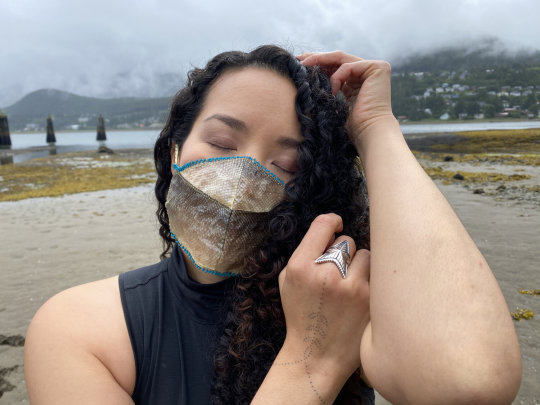

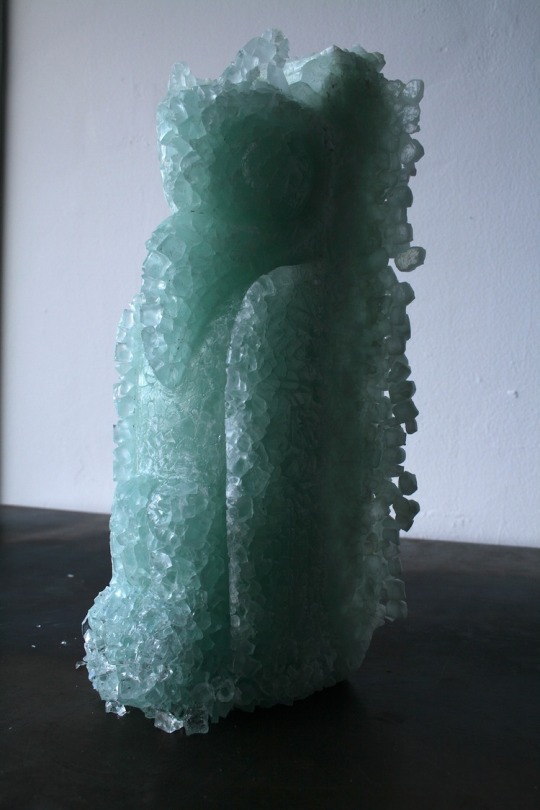

She’s painted some pretty weird (and massive) things, like a basketball court in Sitka (a part of Alaska), a mural that’s 125 feet by 48 feet in Anchorage (Alaska's largest city) and some resin panels which were installed as guard rails in the newly renovated Juneau (Alaska’s capital city) International Airport. Some other strange and cool things she's designed art for include an ambulance, and an entire plane!


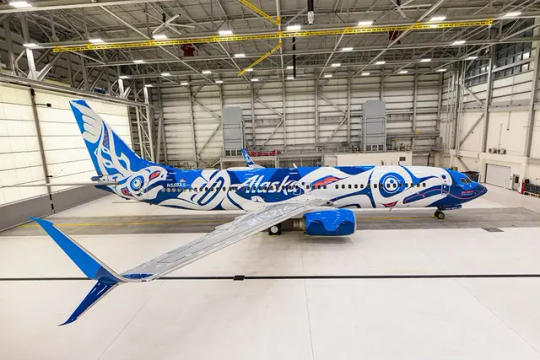
She also has some art that you can use as your Google Chrome background!
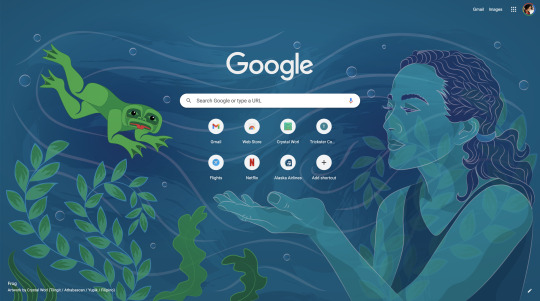
Here is a link to her website, and you can shop her work here. You can learn more about and find out ways to donate/support Alaskan native people here.
#artist features#Crystal worl#athabascan#native alakan#indiginous artist#indigineous people#Feature artist Friday
1 note
·
View note
Text
No. 52 - Alaska Airlines Xáat Kwáani and Salmon-Thirty-Salmon Liveries
Did you think I was done with Alaska Airlines?
No, this is actually my last post about them for now (though, mark my words, you will be seeing a post about the Gold Nugget Jet in the not-too-distant future - I just feel like we need a break from nothing but consecutive posts about the same airline, and I have other things I want to cover). But it's something that's both requested and which I've wanted to talk about for some time.
In my last post I discussed the identity of the man on the Alaska Airlines tailfin. It wasn't a major part of the story, only taking up a small piece, but I did touch on how ChatGPT apparently will lie when asked about the background of the livery. Not only does it falsely attribute the livery to Fred Kabotie, who I'm sure had more important things to do, but it also falsely claims Fred Kabotie, who was Hopi, to be Tlingit. As it turns out, though, Alaska Airlines does have a livery designed by a Tlingit artist.

image: Brandon Farris
Crystal Kaakeeyáa Rose Demientieff Worl is a Tlingit artist known for large public artwork which heavily incorporates indigenous artistic traditions and visual motifs across many mediums. Some of her previous work includes large-scale murals in Alaska and throughout the world and guardrail panels at Juneau International Airport. She feels like the most natural choice possible to design an airliner livery, given the scale and diverse canvases she works with, and in May of this year the airplane you can see looming behind her was unveiled in a brand new livery that I, and a lot of other people, immediately fell in love with.

It's safe to say that this is one of the most ambitious and unique special liveries out there. Xáat Kwáani (which means 'salmon people' in Tlingit) is a beautiful and one-of-a-kind take on the often-noticed resemblance airplanes have to fish.
Salmon fishing is huge in Alaska, both now and historically. Today fishing is a major part of the Alaskan economy and something many people making a living off, but historically they were even more directly responsible for making the difference between life and death for those who lived beside them. A major source of food, they were literally life-bringing to indigenous societies, necessary to survival. Humans and salmon were part of the same ecosystem.
Independent of this fact, airplanes seem to lend themselves to comparisons to sea creatures. They may be called 'birds', but time and time again other people confirm that I'm not just imagining it, they do distinctly look like cetaceans and fish. Very early on in this blog the fact that 747s look like Humphead Wrasse was discussed. Amakusa Airlines, Japan Transocean Air, and Southwest Airlines have all leaned into this fish resemblance, and I'm sure over time my sea creature plane tag will continue to grow. This genre of livery will never cease to delight me.

I think it's fairly predictable that I always loved N559AS, the brilliantly named salmon-thirty-salmon plane. I was devastated when I learned that the livery was going to be removed. I mean...just look at her.

The salmon-thirty-salmon was a very unconventional take on the fish-plane, using a much more realistic drawing than any other attempt. It doesn't even try to transform the plane itself into the fish, which I think is potentially a smart way of accepting the limits of doing so. Instead, it fully displays the honestly hilarious and adorable face that salmon have while providing a nice canvas, a bit of water for the salmon to be carried on. At the same time it incorporates thoughtful details like the scales on the interior winglets, and the way the salmon's body is aligned with the empennage and nose feels very precisely done. It can create a somewhat uncanny doubling effect from a few angles, but by no means is it enough to rob the livery of its charm or elegance.
The salmon-thirty-salmon gets an A.

I've lived near the ocean my whole life. I love fish. I loved this plane. I was heartbroken when I learned the livery was going to serve its final milk run before rolling into the hangar for the very last time, coming out repainted and lost forever. It's always a bitter pill to swallow when airlines retire special liveries, particularly when it involves the plane being repainted into the standard colors. A lot of other people were sad to see this design go too.
What we didn't know was that this was not the end of the salmon-thirty-salmon. She was not lost, but transformed. When she emerged from the hangar again she was not wearing Alaska Airlines' default colors but something even more eye-catching, a livery honoring the same fish but with extra layers of meaning added by means of an intricate and beautiful new design.

Costs, materials, and man-hours used to paint an airplane vary dramatically from case to case, livery to livery, model to model, airline to airline. The numbers in my description are somewhat conservative estimates used for comedic value. Alaska Airlines actually gave some numbers for Xáat Kwáani - twelve days, 117 gallons of paint. The colors used are Midnight Blue and Atlas Blue for the background, White for the fish themselves, and Pink for highlights, and a clear coat has been applied over the top in order to preserve the livery. Alaska Airlines has every intention of keeping it intact for as long as possible.

The use of colors is beautiful. The waves of darker and lighter blue keep it from ever looking too light or too dark, adjusting to the lighting in order to always remain saturated and vivid, and the irregular wave pattern keeps any part of the livery from looking static. The use of the pink as a highlight is sparing but effective. The white, though, is what makes this livery so fantastic. A central tenet of this blog is a disdain for the dominant trend of livery design in recent history, Eurowhite - that of an almost entirely white fuselage. And there is a legitimate sense of general derision for white, but it can be so powerful as a design feature. There is no contrast more powerful than a stark and complete absence, a space carved out fully from the world and color around it. It is the color of bone and snow.

The balance of each color is just perfect, the blue never overpowering the white, the white never fully blocking out the blue, the pink subtly adding depth throughout, and the shapes of the salmon are placed perfectly, not feeling cramped or confined. They are free to wander the fuselage and they have an amazing sense of movement to them, as if caught mid-leap. I've seen salmon swimming upstream to spawn, and they are so startlingly large and vivacious. The fish on this plane, though stylized, perfectly capture the way that these fish look in motion.

Formline is a style of art historically created by indigenous peoples of the Pacific Northwest coast of North America. It was a common and versatile visual element, present in everything from painting to carving to weaving. It is defined by its use of continuous, curving lines which may change in angle, width, and direction but do not terminate. Though it was diminished in quantity by suppression of indigenous culture by US and Canadian settlers it never went away, and from the second half of the 20th century onwards it has been surging back as more and more indigenous artists are able to produce and display their work. Worl has worked with formline many times before. She is quoted as saying:
Every time I looked at an Alaska plane, I couldn’t help but visualize the salmon being in formline [...] I can’t help but look at things and see how to Indigenize them.

And the idea has now come to life in this absolutely unforgettable livery. I wish I was within the range of the 737-800 from Alaska Airlines' hubs so that Xáat Kwáani could pay a visit to my home airport, because this is among the most beautiful planes in the world right now. And beyond just nice colors and pleasing shapes it represents something important - indigenous artists being given a 40-meter-long flying platform on which to honor fish which have provided countless centuries of life to the people who live beside them.

Worl's work is above and beyond what I would have ever expected for a custom airplane livery. Even the 'Alaska' wordmark is neatly incorporated into the formline, blending into the background to the point it's hard to notice in a good way.
Most liveries are designed by graphic designers and branding firms. Landor Associates design liveries and logo, but they aren't building monuments or putting their work in galleries. I don't mean to diminish their work - obviously I'm passionate about it, I have a blog about it - but it's just fundamentally different from what Worl does. It has different priorities, a different philosophy, and a different level of personal investment.
From my perspective Xáat Kwáani feels less like branding material and more like a piece of artwork. This isn't something designed to go on letterhead, to be put in a press kit, to be widely reproduced. It's something to be looked at, thought about, and remembered. This is a mural that flies.
I mean...A+, obviously.
There is just about nothing else in the sky which has the same visual power as Xáat Kwáani. As far as I'm concerned, every gallon of paint was worth it to give us this flying tribute to the people and wildlife of the state Alaska Airlines takes its name from.

129 notes
·
View notes
Note
Have you seen the formline art in splatoon? It's present in a variety of salmon run decals and on some of the locker graffiti. Idk if the Devs just googled "salmon art" and got indigenous art and decided to copy it or what. Not sure how I feel about it personally.
Long post incoming, gonna put a break here. Also sorry for the late response, I wanted to take a couple days to formalize my thoughts together before responding fully.
I have, I remember noticing in 2018-2019 (when i first started playing splatoon 2) how much one of the decals/graffiti located on the ruins of ark polaris back in 2 sort of resembled a formline bear and salmon. (near the logo in this screenshot, I couldn't find a clear picture online)

Back in 2019, it was pretty easy to think of it as coincidence or a stretch for a comparison. But with splatoon 3's salmon run decals, the resemblance is far easier to see, specifically with the TS-ORBRS graffiti and the TS-SCHL graffiti.






(also this was the best image size I could find for the graffiti images, sorry)
A couple of the banners have the designs on them as well:


The website Sealaska Heritage has info such as textbooks and an online doc about formline art (specifically geared towards Haida, Tlingit, and Tsimshian nations' style) with lots of info about formline art, and the Seattle Art Museum website has an info sheet (with credits listed as being from the Sealaska Heritage site as well) breaking down some of the basic shapes of formline art.

with this chart, you can definitely begin to notice the similarities between the Salmon Run graffiti and formline art. the ovoids, crescents, and u-shapes appear noticeably in some of the graffiti such as ORBRS and SCHL.
For perspective, here are some formline pieces featuring salmon or fish from various Indigenous artists from various nations.

"sk’ug sdang" (Two Dog Salmon) by Robert Davidson (Haida)
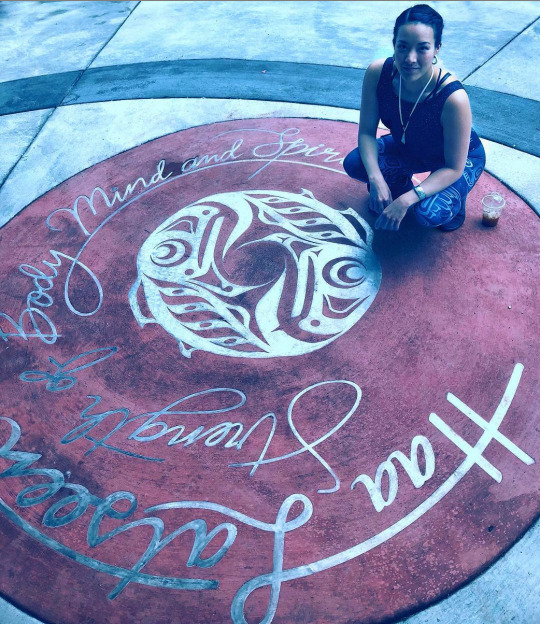
"metal medallion", by Crystal Kaakeeyáa Rose Demientieff Worl (Tlingit Athabascan)

"Salmon People" by Alano Edzerza (Tahltan)
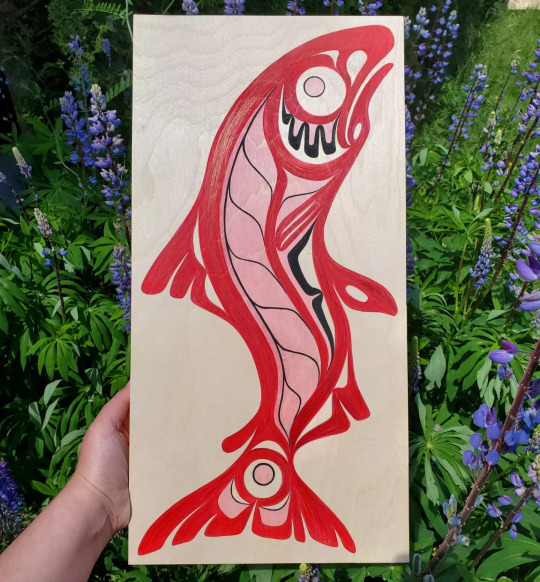
"Jumping Chum" by Stephanie Anderson (Wet'suwet'en)

"Salmon" by Art Thompson (Nuu-chah-nulth)
And that's literally just the surface of dozens of Indigenous artists from the PNW.
With these pieces, you can begin to see the resemblance that the graffiti designs have. A lot of the heads follow the pattern of utilizing ovoids for both the head and eyes, and u-shapes for the bodies and crescents to fill in specific areas are also common. For example, TS-SCHL has a small school of fish where the bodies are entire ovoids.
However, there are a couple flaws in the graffiti designs too. With a few of the designs, you can see they utilize the u-shape (see the formline shape breakdown from Sealaska again) in designs like TS-WHP and TS-SMFR. I can't speak for every Indigenous formline artist ever, but from how I've been taught to design formline art from my family, the u-shape should connect to the rest of the form instead of free-floating. I drew a quick example here:

you can see similar mistakes with a different kind of u-shape with TS-RLPL and TS-C0HK.
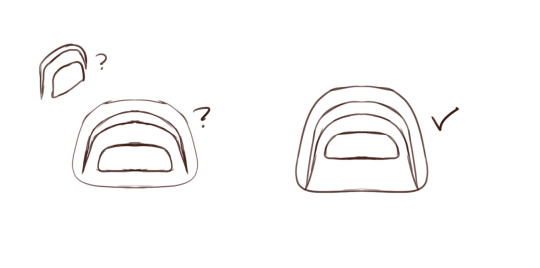
Another very specific mistake that takes a bit of squinting to make out is that ovoids are sort of top-heavy, for lack of a term I can't think of right now. The line or the area should be thicker on the top then the bottom. This mistake is frequent in the graffiti designs utilizing ovoid or ovoid adjacent face or body shapes, like TS-ORBRS, TS-C0HK or TS-SCHL.
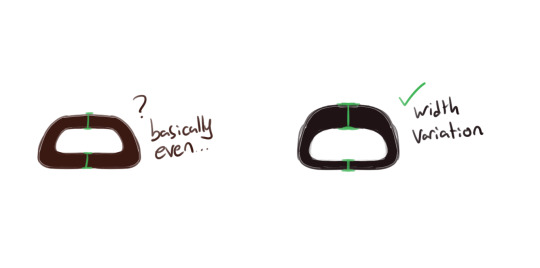
Full disclaimer, I am not an expert at formline art. I've been practicing it under the tutelage of my aunt and father for about 3 or so years now, and there are definitely cultural variations that come into play as well. My culture's formline art style can look completely different from someone who is Haida or otherwise. This critique of the graffiti designs is based off my knowledge and skill at formline art, as well as critique and feedback that I've gotten from family. Formline art isn't just something you look at and replicate, there is a specific process of utilizing the shapes and negative space that you need to account for too. Some shapes have their own rules for how they're used as well.
Despite the beginner mistakes, the clear resemblances are pretty definitive proof that a good section of the sticker/graffiti designs for the salmonids are meant to be, or at the very least based off of or inspired by, formline art.
Splatoon's lore has a lot of elements of taking inspiration from real life culture (which is sort of one of the main elements of the story, the squids and octos are basing their society off long dead humans). Hell, Shiver and Frye are two prime examples of Splatoon working in real world culture into their setting and characters.
With that in mind, using an art style that's exclusive to an ethnicity of people as inspiration or baseline reference for the game mode that's all about taking natural resources from a species that in-game dialogue tends to treat as dangerous and lesser-minded is... not a good choice. Especially an ethnicity that has historically been ravaged and attacked by settlers for natural resources.
Now, technically if you do digging into lore for salmon run, you can find out that the salmonid are not as simple-minded as the dialogue in-game (I am staring directly at the deep cut big run announcement dialogue we've gotten so far -_-) makes them out to be. The salmonids do trades and commerce with the octarians for equipment and gear. That's why they have such technically high tech gear, like the scrappers with their shields that actually resemble octarian shields and the flyfish with their missiles and flying aircraft. That's also why power eggs show up in the story mode; they're from the salmonids' trades with the octarians.
So the salmonid could technically be as just as smart as the inklings, which is why the dialogue and some of the portrayals of the salmonid are confusing and contradictory (shiver's dialogue from the first big run, that one promo picture of an inkling walking a smallfry on a leash????). I think a good bit of the fanbase sort of thinks of the little buddy we get during the game as a pet, and I'm sure that much more of the fanbase/playerbase doesn't really care about the lore whatsoever. Salmonids sort of have a similar vibe to me as hilichurls from Genshin Impact, where the lore tells you that they're smarter than people assume while NPCs talk of them as less intelligent monsters. And you're also caught in this paradox where killing/fighting them feels morally wrong but the gameplay loop has you continuously doing that while also telling you on the downlow that you should sort of feel bad about it.
Rassicas did a really good video on translating salmonid lore from various interviews, which is where I learned a lot about the salmonid lore that doesn't really get explained/brought up in the game.
The usage of formline art in Splatoon has me sort of mixed on my opinion, because besides using an Indigenous art style for an enemy species that are considered lesser in intelligence by the NPCs, Indigenous art and culture as a whole has suffered a lot under colonialism. I don't know how much awareness whoever is reading this has about Indigenous history and colonialism, but Indigenous culture as a whole was banned in North America by the respective governments from being practiced by the respective cultural groups. Things such as ceremonies, regalia, and even practicing formline art were banned from being used by Indigenous people. Non-Indigenous people however were free to use it, which is why a lot of bastardized versions of Indigenous regalia and culture exists. You can see it in non-indigenous spiritual practices utilizing Indigenous practices and terminology like spirit animals and dreamcatchers, and sports teams utilizing Indigenous culture in its labelling and mascots. That is where cultural appropriation comes into play. And before I get anybody commenting about this, the salmonid formlines don't count as "cultural appreciation" because as far as the info available is concerned, there wasn't any Indigenous people that were consulted for the designs. And even if there were, I again have mixed feelings about Splatoon utilizing an Indigenous art style as a design piece for an enemy character in the franchise.
On another note, this isn't the first time Indigenous cultural appropriation has popped up in the Splatoon franchise. There was actually a headgear that was unreleased in the first Splatoon game called "Warrior Headdress", and you can guess what it looked like.

Yeah. That was all levels of yikes and I'm thankful as hell that it didn't make it into the game (technically it's not in the game as a wearable item, but you can spot it at the very back of the headgear shop ingame)

So Splatoon has utilized Indigenous culture as inspiration beforehand with the games, so it's not much of a stretch anymore to think that the salmon run graffiti designs were based off formline art or was an attempt at formline art.
I'm not really sold on the idea that the salmonid are meant to be representative of Indigenous people though, nor do I believe that utilizing formline art for the salmonid was a malicious decision. But it was a slightly ignorant decision at best, because again using Indigenous specific art for a species of enemies that gets fought for their natural resources and is referred to by some of the NPCs as basically being lesser-minded animals is really not a good decision.
This whole thread is not meant as a guilt trip for anyone who likes the salmonid lore, has bought any of the salmonid graffiti stickers, or enjoys salmon run, nor is it an accusation of the devs for maliciously misusing Indigenous culture. I actually really enjoy salmon run for it's PSP and concept, but this design aspect gives me mixed feelings as an Indigenous person. And to be honest it's hard to label intentions or the thought process because there isn't any info available on the development of salmon run and those graffiti designs specifically. So it's hard to know if the devs employed an Indigenous artist for feedback or if they indeed just looked at some formline art of salmon and tried to replicate it or used it as inspiration. I'm inclined to believe the latter judging by the beginner formline mistakes seen in some of the designs. There is an art book coming out soon for Splatoon 3, so maybe that will give more info.
To wrap this all up, I don't think there is really anything to be done about the designs. The game has been out for a while and I don't know if the game would change the designs at this point. I also don't think this should stop people from buying the sticker designs in game or playing salmon run. However, it is important to learn about the context of these designs so that you know why they exist and why they can be harmful, and so devs and creators can avoid making the same mistake in the future, and so Indigenous issues with cultural appropriation can be made more aware in the public space and not be ridiculed by non-Indigenous people. And again, I am just one Indigenous person so there may be other opinions from other Indigenous people on the graffiti designs and how they should be handled or viewed.
If you made it this far, thanks for reading and have a good day!! Be sure to check out some actual Formline art made by Indigenous people, like the ones I listed near the top of the post!
#long post#salmon run#indigenous discussion#cw cultural appropriation#whoof that took a while to write#I really don't think this whole situation is one of maliciousness#but one of ignorance.#the devs had the foresight to (almost completely) remove the headdress item from the first game#so good on them for that#I just sort of wish they'd thought through using Indigenous art for the salmonids a lot better.#I wish the salmonids had a different sticker design entirely tbh#graffiti is such an open-ended style concept so they could've found lots of inspiration there#instead of using an Indigenous specific art style#(and making beginner mistakes while doing it)#also if you're here to cry cultural appreciation or about how “oh this is preserving Indigenous culture actually” I'm gonna need you#to walk back out that door.#I did not spend four hours writing this whole post to deal with “but cultural appreciation actually!!!” chuds.#Look up the definition of cultural appreciation vs cultural appropriation and get back to me.
267 notes
·
View notes
Text
The title card that opens 1979’s original Mad Max places the action in a very near future, looming just “a few years from now.” George Miller’s cult action-thriller captured the edginess of a world teetering on the brink. The film depicts a not-quite-postapocalyptic Australia, where gangs of high-octane galoots rove the roadways on motorbikes and souped-up muscle cars, attempting to outrun the last of the lead-footed policemen: Mel Gibson’s Max Rockatanksy. Revisiting the film is exceptionally rewarding—and not just because of the grit, oddball humor, and verve of Miller’s directing. It reflects something of the ambient tensions of a world of potentially perilous fuel shortages, which threatened the whole petrol-and-plastic framework of our modern world.
Miller recalls this era with no particular fondness. He remembers, in the mid-’70s, all of the gas stations in Melbourne shutting down. Save for one. The mood was sour. The tension was thick. “It only took 10 days,” Miller says, “in this very peaceful, benign city for the first gunshot to be fired. Someone got ahead of a long queue, that went on city blocks, to get fuel. If that could happen in just 10 days, what would happen in 100 days?”
Across five films, including the new Furiosa: A Mad Max Saga, Miller’s franchise tracks this decline. In the original picture, the world is still fairly intact. There are diners and hospitals and happy families. People even dress more or less normally. It can feel a bit like our world: one which is collapsing but hasn’t yet totally buckled. By the time of 1982’s Mad Max 2 (released in the US as The Road Warrior), any vestiges of civilization have been blown away by an accelerated period of resource warring, nuclear conflict, and ecocide. Humanity survives in clans and roving bands, dressed in feathers and dusty leathers.
By 1985’s Mad Max: Beyond Thunderdome, civilization relies on bartering for commerce, harvesting pig shit for methane, and conflict resolution by way of gladiatorial combat. In the smash hit 2015 long-gap sequel, Mad Max: Fury Road (which recast Rockatanksy, putting Tom Hardy in the lead), things were almost cartoonishly bad: Fertile women were ferried across vast wastelands in tanker trucks, access to fresh water was hoarded by tyrannical dictators in skeleton half-masks, and all of humanity seemed to exist in a state of berserk, whooping madness. If that first film was warning—against the fetish for speed and power, against excessively extracting precious riches from a planet that could scarcely afford to give them up—the newer pictures feel not so much prescient as present: sado-comic visions of our own maddening, resource-starved world.
The Mad Max films are driven by a guiding incoherence. They offer a critique of car culture, resource scarcity, and the very things that may well have our world motoring toward its own demise, no matter how many EVs we buy. Denizens of the desolate wastelands exalt automobiles, motorbikes, engines, and especially gasoline as fetish objects. But at the same time, the films’ pleasures are guilty of this same exaltation. The thrills derive from high-octane racing, dangerous automobile maneuvers, body-mangling crashes, and the whole vroom-vroom of it all. They’re like war movies that ask us to thrill at the violence and daring of combat, while all the while muttering, “This is actually really awful, you know.” There is no effort to reconceive a world doomed by its pathological obsession with machines chugging on crude oil. Rather, the apocalyptic backdrop only furnishes fantasies of further decline.
Perhaps it’s a mistake to take films with characters called “Pig Killer,” “Rictus Erectus,” and “Pissboy” too seriously. But the Mad Max pictures underscore a deeper absurdity that undergirds the genre of postapocalyptic, ostensibly environmentalist (or at least environmentally sympathetic) entertainments that are often referred to as eco-fictions, or cli-fi, for “climate fiction.” “The climate crisis and grotesque climate inequalities are things that we are really struggling to process,” says Hunter Vaughan, an environmental media scholar at Cambridge University. “These films are touching on our collective inability to adapt to this crisis.”
Vaughan is the author of Hollywood’s Dirtiest Secret: The Hidden Environmental Cost of the Movies. His text analyzes the environmental impact of the film industry, from early Hollywood to the present. Understanding the industry as inherently (and devastatingly) resource-reliant, he has come to view the very idea of “environmentalist movies” as a bit of an absurdity. “Films like Mad Max and Avatar,” he explains, “are just doing what Hollywood has always done, which is rely on choreographed violence and the enticement of spectacle. But they get to offset that to some degree by coming across as having some sort of environmentalist message.”
The whole notion of “cli-fi” as a genre suggests something a bit ominous: that the well-meaning parables of early climate fiction have now become subservient to the demands of the genre. Take Denis Villeneuve’s Dune pictures. While perfectly competent as pricey pieces of blockbuster cinema, they barely engage with the novel’s ecological concerns. Author Frank Herbert was originally inspired by the historical ability of certain indigenous civilizations to live in harmony in even the harshest environments—a noble idea that, in the Hollywood version, takes a backseat to woolly ideas around interstellar jihad and the sheer pageantry of the proceedings. Likewise, Mad Max's original warning siren has waned a bit, as the films developed their own generic language. The collapsing world is now just a canvas across which (wildly entertaining) action scenes unfold.
However absurd it may seem to scholars, Miller seems to come by his environmentalist sympathies honestly. Even outside of the Mad Max movies, many of his pictures touch resonant themes about global warming (Happy Feet), vegetarianism (Babe and its sequel), and the essential destructiveness of the modern world (Three Thousand Years of Longing). These realities have directly impacted his films. Fury Road’s production was long delayed, in part, because the Australian desert where Miller planned to film was suddenly swamped—a direct result of unpredictable climate patterns. “I see it myself,” the director says of climate change. “It’s all around us. I’ve seen both the hard statistics, and just in my own experience. So it can’t help but seep into the story.”
Furiosa is unique among the Mad Max films in that it offers an alternative to the arid, violent, boiling wastelands that dominate the franchise’s topography. The origin story of Charlize Theron’s fierce road warrior from Fury Road, the film opens in “the Green Place”: an Edenic garden governed by a tribe of warrior-women, which stands out as a lush oasis in the desert. For Miller, Furiosa offered an opportunity to one-up himself. Fury Road proved he could make a hit Mad Max movie without Mel Gibson. Now, he hopes to show he can make another without Max (though he does appear, very briefly). “If you just do the same thing again and again, there’s hardly any point,” he says. “There’s an inherent cynicism to it.”
Snatched from safety, Furiosa (played by Ayla Browne as a child and Anya Taylor-Joy as an adult) is raised among a motorcycle death cult, led by the madman-prophet Dementus (Chris Hemsworth, sporting an impressive prosthetic schnoz). In time, she’s traded away to Immortan Joe, Fury Road’s big bad, and learns to survive and thrive among his clan of face-painted, aerosol-huffing cultists. Building out the world of Fury Road, Furiosa traces the fragile trade dynamics between three strongman leaders, each hoarding a key resource: fresh water, fuel, and bullets. As Furiosa navigates these violent trade routes, she hatches her own plan to avenge herself on Dementus and burn rubber back to the Green Place.
In actually bothering to imagine what some alternative to the wasteland might look like, Furiosa moves past the typically narrow horizons of most cli-fi. Nicole Seymour, who teaches environmental literature at California State University, Fullerton, notes that most environmentalist narratives stop short of actually conceiving of what a new, better world might look like. “I think that would require you to do more implicating, and more work,” she says, “which no one wants to do.” She notes that most utopian environmentalist literature tends to buck the mainstream, foregrounding more diverse characters. “Do they want to make a movie about a Puerto Rican transgender person who time-travels?” she asks. “I would watch that!”
There’s a shopworn quote attributed to the late critic and theorist Mark Fisher, about how “it's easier to imagine the end of the world than the end of capitalism.” Certainly, in the Mad Max movies, the basic systems that led to our destruction—resource hoarding, the primacy of tribal violence, the fetish for power and speed—remain intact. The sinister logic imparted to the audience is that, well, ecocide is inevitable, and so there’s little left to do than revel, laughing mad, in the explosive spectacle of our own destruction. To which an admirer of these films (like this writer) may sensibly, or cynically, respond: OK, sure … but what a spectacle.
For his part, Miller maintains that there’s a deep humanism at the core of these films, buried beneath the scrap heaps of twisted metal. “I’ve been to places where there is a lot of trauma and poverty,” he says. “I’m always impressed by the ability for survival. This is about our survival.”
15 notes
·
View notes
Text

downloaded on my phone tonight to try the invite a friend thing (have no clue how to do so). with the free gems i got i decided to pull and yayy!! wish this was my main but im glad i even got anything
my friend lost allll of her crystals pulling for wedding an so rip
also this is a scheduled post so itll go up when im asleep (probably), hope it worls
#my friend had like 42k saved up too#the gacha gods have always favored me. first banner i pulled when i started >#< cherry blossom rerun#i got the limited len wnd miku in the same pull.#saving up on my tablet acct for the n25 events#this was acquired in 3 ten pulls so yippie !!#i also got a 4* shiho. dont remember which one
4 notes
·
View notes
Text
Persona Empires Lore- My fansona
Intro
Aiko Masaru is the protagonist and thus has the wild card and leader of the court. She is also in possession of pocket mirror that acts as a compass, glowing when near the entrance to a forest. The enterance is a dead flower, and after going once, the dead flower will turn into a crystal version.
Mirror world
The forest isa place the victim has control over, the safe areas have the white versions of the flower with sunlight coming through. The center of the forest has a garden based on one of the famous fairytales such as Alice in wonderland.
The victim, and ruler of the garden is not a bad person and will not gain a persona. Rather, they are on deaths door after failing to do so themselves, expirienceing similarities to the hanahaki disease, but over time it gets more severe. First flower petals, then tatoos, then vines and eventually they die. The ruler is loosing their will to live and they need the ruler to help them continue on breathing.
The entrence is a flower the victim hold dear, like a rose, and that is the flower the victim coughs up. While interfearing with a garden can lead to saving the victim, it can speed up the death if not done fast enough.
When the flower crystalizes it must be taken to the magic mirror in Aiko's home and that mirror can be used to appear at any checkpoint in the mirror world.
Mascot
The mascot of this world is a mute scale swan named Divinity. She's bassicly half-dragon half-swan in the mirror world and a mute swan in the real world. Her right eye is a sapphire and the left is a ruby, no pupil or scalera, they litrally look like gems. She also has a ribbon that is red turning blue with a golden feather with her name. And no, she can't talk.
Persona
When awakening a persona a crown appears in front of them and they transform into a fancy royal but still combat friendly. They don't need skin tight suits live persona5 since they're not theives, but they do have their own themes. And when summoning the persona they throw the crown into the air. In the real worl the crown turns into some sort of hair/head accessory like a headband or hairpin.
4 notes
·
View notes
Text
Lingshan Hermit: A Brief Introduction to Offerings
There are three kinds of offerings. At first, we take tangible material things that we consider precious and make offerings with them. Based on these offerings, we accumulate tremendous merit. If this merit is used correctly, it will facilitate our practice.
In the Buddhist tradition, Buddhists take things they consider good and valuable and make offerings to the Guru and Three Jewels. Such actions accumulate merit for them. If we want to attain enlightenment, we need to have immense merit. For this we need to do many things to accumulate merit. To avoid regret after making offerings, the Buddha and great masters devised the ritual of offering pure water, because no one will regret offering water instead of gold. Starting with offering pure water, we slowly begin to offer butter lamps, offer our time, or more things. This guides us to gradually train in renunciation. When we speak of renunciation, it doesn't mean we throw away the things that belong to us. What we need to renounce are the things that never belonged to us but we mistakenly thought did. We scheme endlessly for those things that never belonged to us, and they firmly ensnare us in samsara.
Perhaps you are still making mandala offerings, symbolically offering the entire universe to the Guru and Three Jewels. Your Guru may say the mandala must be made with good gems - you should buy some red coral branches, or gold dust, nice crystals, not rice. He may make such demands of you. He makes these demands because for you, gems are more precious than rice. —Renouncing precious things allows us to accumulate merit— not because Buddhas and Bodhisattvas prefer coral branches.
The offerings of most people remain at this stage. If they do not strive very diligently, they may remain stuck at this stage forever, always thinking this is what offering means. But there is a deeper, more profound kind of offering. This deeper offering may occur when you interact with your Guru. At that time, your practice is already very advanced, you and the Guru have established trust, and the Guru has started to dismantle your samsara. What you need to offer will also change accordingly. If previously you only offered material things and time/energy, now you may need to offer your most cherished possessions — intangible things, like your views, your habits, your aesthetic taste, the things you think are absolutely right — for most people, offering these things is much harder than offering a piece of gold. If you are a staunch feminist, and your Guru knows this very clearly, but he says to you: feminists are just a bunch of lunatics. Can you remain unperturbed? Or immediately give up your previous view? If you don't, if his words upset you and you have no intention of accepting them, then you have not offered up your view. You still think it's right, your view is unshaken, still in its original place, not budging one bit. You feel it is a part of you, like your ears or potbelly. But it was never a part of you. Your so-called view is just the result of you being influenced by forces beyond your control — newspapers, TV, the internet, social media. It was never your original idea. Never belonged to you. Your views, your preferences, your perspectives, the things you think are right, are actually the very source of your suffering. When you cling to these things, anyone can pinch you and make you suffer horribly. The Guru's job is to dismantle your samsara, so he needs you to slowly offer up your views, preferences, the things you think are right. These things comprise your samsara. To offer means to give away, to no longer possess.
Finally — if you're fortunate enough to practice to this stage — we experience the most sublime offering. We give up our habit of grasping, interpreting, and labeling all manifestations. We offer up our interpretations of all manifestations. We offer up the conceptual world we created. We offer up the entire projected world. We offer up all manifestations. This is our most perfect offering.
This was originally published on Lingshan Hermit's Weibo and Google Blogger on July 23, 2020. Copyright belongs to the author. Reproduction without permission is prohibited.
Copyright Notice:All copyrights of Ling Shan Hermit's articles in Simplified and Traditional Chinese, English, and other languages belong to the natural person who owns "Ling Shan Hermit". Please respect copyright. Publishers, media, or individuals (including but not limited to internet media, websites, personal spaces, Weibo, WeChat public accounts, print media) must obtain authorization from Ling Shan Hermit before use. No modifications to the articles are allowed (including: author's name, title, main text content, and punctuation marks). We reserve all legal rights.
灵山居士:供养略说
5 notes
·
View notes
Note
so, I'm not exactly sure if this is intentional? or if your game seems extremely aware of what kind of challenges worl best from genetics, but my land is... interesting. and I'd like to be sure it's normal.
it does appear that my land was generated significantly larger than my allies ones, thicker, entire surface is smooth dark stone. and spawned my house directly underground. I would consider this relatively normal if odd. if it weren't for the fact I relied pretty heavily on the ability to fly, an ability that's been heavily restricted here.
hell, there's even large crystal structures full of grist replacing larger enemies that wouldn't fit in the cavern system, and all the creatures here talk about wanting to see the surface. a surface that thanks to all the larger spawns being up there will highly incentives flying.
I'm guessing this is skaia just being clever, but gotta ask if the land is anomalous.
A lot of the behind-the code-work we've spent hellish time in 5.0.0 development on was balancing the starting areas. And the initial part of the game relies heavily on doing the legwork and progressing through the entry areas on foot, slowly.
That si not to say that we have a line like "IF (Player) has tag (fly) THEN execute {nerf.hmr}. THIS dies;". It's a bit more nuanced than this, and for example it wouldn't trigger if the rest of your team was capable of flight from the beginning.
So while your situation is uncommon, it is well within the game's boundaries.
Sincerely
SN Tech Support (Gear)
3 notes
·
View notes
Text
Zeal Optics and Haa Aaní Alliance Unveil Collaborative Ski Gear with a Purpose
Haa Aaní Alliance gear sales protect free-flowing rivers and salmon spawning grounds
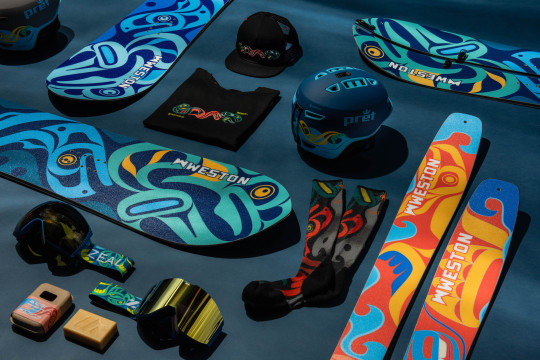
Boulder, Colo. – October 10, 2023 – Zeal Optics, in partnership with Weston, Smartwool, Pret, and MountainFLOW Eco-Wax, have joined forces with Tlingit artist Crystal Worl of Trickster Company to form the Haa Aaní Alliance and launch a collection of goggles, skis, snowboards, socks and accessories featuring Worl's artwork, with proceeds benefiting three non-profit organizations: Yukon Salmon, Wild Salmon Center and the North Atlantic Salmon Fund. Zeal will donate $5 from every pair of Haa Aaní goggles sold.
“I’m thrilled to create art on outdoor gear that will bring attention to Indigenous values and knowledge around Xâat Kusteeyí, the Salmon Way of Life,” said Crystal Worl, whose art is featured across the collection. “I grew up fishing and learning how to care for and respect salmon. I also grew up skiing and spending time outdoors in Alaska. It’s been an incredible journey to live and love this land as my ancestors and family have for generations. There is much to learn from the salmon, and time is running short. I have big hopes and dreams for what my art and storytelling can do to make change.”
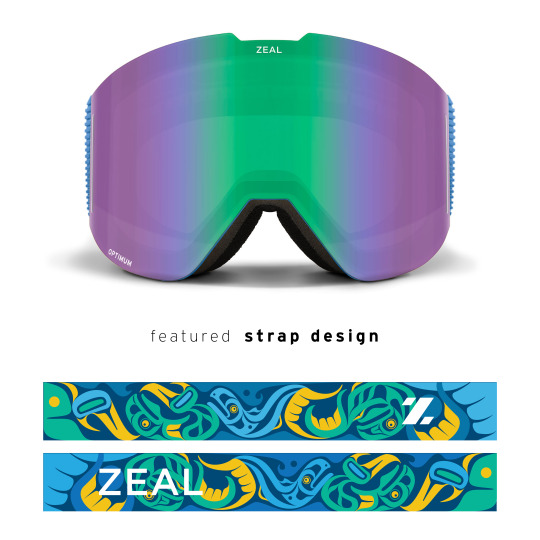
The central aim of this project is to protect the uninterrupted flow of rivers and vital salmon spawning grounds that are essential for the preservation of both human communities and the ecosystem, in alignment with the principles of Haa Aani and the Salmon Way of Life, Xáat Kusteeyí. For the Tlingit of Southeast Alaska, culture revolves around the land and its resources. The Tlingit believe that when they take care of the land and its inhabitants, the land, in turn, takes care of them. The Tlingit phrase “Haa Aaní” often summarizes this concept, which means “Our Land.” Animals are viewed as members of the same social universe as those beside them. Art, dance, stories, and crests reflect these relationships with nature. Xáat Kusteeyí, as an extension of Haa Aaní, focuses on utilizing salmon respectfully and sustainably. By protecting the salmon and its habitat, the salmon provide people with sustenance in return.
The Haa Aani Collection designs are available now for Zeal’s Cloudfall and Lookout goggles. Visit zealoptics.com/haa-aani for more information.

4 notes
·
View notes
Text
A TUMBLR STORY: TORN PAGE (p.1)
Light fades, and with it, darkness comes to be.
Void has no smell. It has no sounds, nor there’s a thing to see. Nothing is what caresses skin, its touch bearing no feelings. No cold chills bones, no heat warms mind and heart. The emptiness is omniscient, all-present. It weighs, and yet, its heavy pressure bears no harm – it doesn’t exist.
Void isn’t place for someone with remains. Sparks don’t ling love without air to maintain their flame, and so is Mind dependent on external stimulus. Inside the void, sanity fades away – no creature, not even a god, is able to resist what Nothing is. Yet, here you are. Alive where Life and Death dare not to show their thousand faces.
You want to scream, perhaps, but there’s no air to let you breathe. You want to know, but there’s no knowledge left around for your consumption. Your mind, too lively for this place beyond existence, remains trapped in the sole truth that still defines you – that there’s nothing else.
Hold on to it, for it’s the sole thing that can be perceived in Nothing. Claw to your conscience, as it threatens to disappear. You don’t know how long you’re left, here. Perhaps, you’ve been here centuries; perhaps, these were few seconds that you’ve had to live. Where Time is not a king, you’re left unbound to laws that ruled over your soul and body. Now, free of all, you’re bigger than you ever were, only to see how you’re still part of Nothing.
Stars blink. Not in the void, there’s nothing there for you. In your eyes, blinded by the darkness, light suddenly appears again, curious visitor that seeks response. You’re eager to reach out – your scream becomes an audible whisper, your eyes reflecting a caged creature that had been forgotten. You’re still there, despite all.
Congratulations.
***
It’s raining. Hiding from the cold drops, you open the big door and enter the warm premise, greeted by the subdued dance of a dozen candles.
You’re in a tavern. Lamps hang above your head, reflecting many colours, dyed crystals shaped into many forms. Bright wooden walls, covered in paint of rainbow palette, bear childlike presence of naïve décor, tints blended into messy patterns without clear design. Wardrobes stand around, their waists twisted into odd positions, peak and foundation different in size and shape. Tables – made with equal accuracy – hold lamps without fire nor light, only dark smoke of a purple tone raising towards the messy ceiling. A couple creatures sit around, drink in hand. They barely notice your entrance.
“Ah, finally.”
A voice calls for you, sympathetic. Like songs of seas and rivers, its melody reveals you nothing of its owner. It has no age, no start or end present in its cheerful notes. It has no identity, its overwhelming wave drowning perceptions in its flow. It has no description, being all things at once and none of them at the same time. You can hear it, and yet, you question your own ears to be tricking your mind.
In front of you, behind the bar, a man stands. You’re quite sure they’re a man, at least, for now. Their ginger hair covers their ears with smooth, straight locks, their skin dyed by the light of candles. Their eyes are green, greener than grass or trees, emeralds paling in their presence. Dark diamonds rest on their eyelids, their brows and cheeks, two tattoos decorating what surrounds their vision. A hat stays on their head, a bigger one than they’ll ever need. It’s of obnoxious forms, its colour changing every time you try defining it. Two feathers stick out of a decorative band, a clock caged in the golden frame that holds them. Some flowers finish off the odd creation, their blossom set on repeat every other minute.
“New here, I see,” they smile, carefully cleaning a new glass. “Sit, be at home. We do all kinds of drinks here, I’m sure I’ll find your fit.”
Their smile is big and happy. Leaning with one hand on the table, they look you right into the eyes.
“So, where are you from? What’s your poison?”
KNOWN WORLDS:
Therania – Located on the verge of the Synara system, it rests quite far from the Universe’s centre. Having quite a thick energy layer, creatures there have developed energetic affinity, and learned how to control the invisible core of the material plane. Stagnant in scientific progress, it’s nonetheless considered one of the most powerful magical systems in the Cosmos. Its most prominent species are humans, elves and satyrs, although some others also walk its soil away from stranger gazes. Its main religions are the Old Gods and Fate, with Fate currently set as the one official faith for all human civilisations. It’s ruled by the Law of Black and White.
Myria – Located in the Haptra system, it isn’t far from other sentient worlds. Their energy layer was damaged by the One Star War, and now it’s considered vulnerable to otherworldly incursions. Underdeveloped after the lich Ego practically erased its strongest civilisations and took over an entire continent, Myria nonetheless shows a steady progress both in magic and science. Its most prominent species are humans, elves, dwarves and undead. Smaller civilisations include winged-walkers and dryads. Myria is also polytheistic and has no prominent church that raises above others. On world-scale, Myria believes in the Law of Black and White – however, many there know that nothing is so simple as a fairy tale.
Earth – A world located close to the Universe’s centre. Nothing is known about its energy layer or its potential. It’s a world of scientific progress, with magic forgotten by its only remnant human civilisation. It’s thought to be the cradle of the human species, once open to the worlds beyond. In places that still keep knowledge of this now closed realm, its name has one accepted meaning – “Where Gods live.”
Talhik – No one has ever heard of this world before. You’ll have to define it for us yourself (Initiate a week-long day-by-day story update to define a world between us all).
12 notes
·
View notes
Text

Raven Moon and Stars
Crystal Worl
127 notes
·
View notes
Note
Extremely important question. What’s Althaea’s favorite Barbie movie.
THE BARBIE DIARIES!!!! but a LOT of people dont know abouy the barbie diaries, so if we're talking strictly like the super magical fantasy ones like nutcracker and such that more people know about id say Island Princess :]
funnily enough i had many like, original drafts of my joke au where Althaea somehow manages to appear in modern times eorzea (usually hand waved away as ''the wol collected enough shards of azem that they accidently re-awaken), and one of the original drafted ideas was that when Althaea appears, she has entirely no recollection of who she once was Because she lacks her azem crystal like how emet was using the crystal memories for the ones he woke up, so not only does althaea Not Remember any of her shard selves, but not much else about her amaurotine self either besides some basic facts and the way they used to live, so while she has no clue who she is In Specific, shes also amazed by this world she's woken up in that feels nothing like what little she remembers
She gets found and taken aboard a pirate ship thinking shes some castaway or poor soul thrown off board, and she only continues to amaze and endear the captain of a ship (a lonely but faithful duskwight woman), as she soons finds out Althaea has no understanding of Anything in the modern worl of eorzea; she has no idea what ships are, why people wear such different outfits, etc. I entirely based it off the song I Need to Know from island princess v
youtube
I've thought about coming back to this, because originally in the story the pirate crew were going to attempt to pass her off as a princess/woman of royalty from Ishgard to the people to swindle an immense amount of money from various people through some sloppy plots, and the duskwight captain tries teaching her how to pretend to be a princess. It's a secret ger crew doesn't know, but she was adopted by an Ishgardian minor noble house and never knew her true family or if they even wanted to give her up, and she always hated ishgardian nobility, so she left dodge before she was even twelve summers old and became a pirate's deckhand in lominsa to escape the suffocation of just Not Knowing the truth of things, and this is why she can understand Althaea's situation so well; she too feels like she dosnt know who she truly is, but shes trying to make her own image and rised to become her own pirate with her own crew to fill in what a lack of family and belonging left in her
Althaea does get pretty good at pretending --- so good actually with the captains training, that the word of an ishgardian noble daughter re-appearing in eorzea from a pirate ship makes its way back to Ishgard, and the captain's family believe it is their daughter and call for althaea to be returned to ishgard at once. they agree, if not just to get them off Althaea's back whence they realize Althaea doesn't look their missing chilD
BUT when they finally meet and the family exclaims that althaea IS their missing child, the captain becomes rapidly suspicious of whats happening, and soon Althaea and her get wrapped up in an intricate lie to see what the captain's family wants with Althaea
The problem is in the same breath that the captain and crew are now suspected of having stolen Althaea away from them, or at least heavily suspicous for having a lost noblewomen living with them, and the captain and her crew have to go under hiding so that they wont be found out and taken to trial while also staying close to Althaea and making sure nothing happens to her. to do THIS the captain and her crew scatter across eorzea, while the captain shadows as a duskwight miner whos come from the twelveswood to make some money. Through this chaotic mess the captain is now without her crew, the woman shes grown to be extremely fond of, and all shes worked hard for just to fabricate another false self; but she wants to help Althaea out of the mess she put her in, and Althaea sneaks to one of the mining caves to tell her that she's willing to see this plan through and uncover what the captain's family is doing, no matter the cost.
It becomes a sort of princess and the pauper esque thing that gets sort of funny and complex from here but the basic is that the captain's family has always struggled to have children, so when their adopted daughter disappeared they thought this was the end of their house and their name, so when a random ishgardian noble daughter re-appeared they scooped her up immediately to use her to carry the name, and immediatly began seeking suitors for this child hoping that it will bring in the money and stability they lost long ago
they do find a few suitors, lowborns with decent wealth from trade and a few minor house nobles seeking to merge their families, that are interested in Althaea's hand. One of the most prominent suitors that comes to visit Althaea though is from a man out of town --- he is no ishgardian, no noble, his name carries no weight, but he is wealthy and seeking a wife, and he can bring wealth to Althaea's family if not to make up for a lack of a name to carry her on. Her ''family'' disregards him immediately, but Althaea finds him incredibly sweet and kind, and Althaea routinely meets with him after her tea times with possible suitors to get to know him more. however, Althaea does not want any sort of marriage to go through --- not because shes lying about her place as the lost noble daughter, but because she has grown affectionate towards the pirate captain, and it doesnt feel right to make a fool of another man giving her his heart in this way.
realized im just rambling about a random oc au and idek if you know anything about ff14 so im going to stop here before this post becomes a mile long ARCK
5 notes
·
View notes
Text
Apple Watch Ultra 2 In Black Titanium: A Bold Look For 2024

Apple Watch Ultra 2 Black Review
The ideal sports watch has sleep apnea notifications and a gorgeous new finish and Titanium Milanese Loop band.
Apple Watch Ultra 2 Black Titanium band
Apple unveiled Apple Watch Ultra 2 in a beautiful black titanium finish with watchOS 11 improvements that improve the most robust and competent Apple Watch.
- Advertisement -
Apple Watch Ultra 2 is perfect for athletes and adventurers of all kinds, with the most accurate GPS in a sports watch, the brightest display of any Apple device, and up to 36 hours of battery life with typical use or 72 hours in Low Power Mode. The finest sports watch now has breakthrough insights from training load and the Vitals app, sleep apnea notifications from the Tides app, new Action button customization options, and more with watchOS 11.
A new Titanium Milanese Loop band for Apple Watch Ultra is lightweight and elegant for any occasion, perfect for water activities. New Apple Watch Hermès Ultra 2 has the durability and features of Apple Watch Ultra 2 with a nautically inspired watch band and special Hermès watch face.
Apple Watch Ultra 2 Black
Pre-order the black titanium Apple Watch Ultra 2, Hermès Ultra 2, and Titanium Milanese Loop today for availability on Friday, September 20.
Apple Watch Ultra 2 is now available in a gorgeous satin-black titanium finish people will adore for its striking beauty and durability. WatchOS 11’s revolutionary insights make it even more powerful.
- Advertisement -
Beautiful New Black Titanium Finish and Bands
Custom blasting gives Apple Watch Ultra 2 its new black titanium look, and the diamond-like carbon physical vapor deposition coating over grade 5 titanium makes it scratch-resistant and durable. Matching dark zirconia makes up the rear crystal.
The popular Trail Loop, Alpine Loop, and Ocean Band now include black hardware in addition to natural titanium to match the new black finish. With either Titanium Milanese Loop, Trail Loop, or Alpine Loop, Apple Watch Ultra 2 black and natural finishes are carbon neutral and constructed from 95% recycled titanium.
The first metal band for Apple Watch Ultra, the Titanium Milanese Loop, is inspired by divers’ mesh and fashionable enough for any occasion. Like the case, the band is made of aerospace-grade titanium and is both lightweight and resistant to corrosion. A proprietary method of weaving, flattening, laser-welding, grinding, and delicately polishing titanium wire creates precise, interlinking lozenge shapes with a sumptuous drape and a dual-button, parachute-style buckle for all water activities. Natural and black titanium will be available for the Milanese Loop.
Apple Watch Ultra 2 Features
Enhancements for All-Terrain and Water Activity
Apple Watch Ultra 2 has the brightest display Apple has ever made at 3000 nits, perfect for outdoor activities. Many activities require GPS precision. Apple Watch Ultra 2‘s precise dual-frequency GPS uses powerful satellite and signal models, unique positioning algorithms, and Apple Maps data to give the most accurate distance, route maps, and metrics in a sports watch.
The new Vitals app in watchOS 11 lets users rapidly monitor nightly health measures and obtain health information. The training load function provides a new approach to track how workout intensity and duration affect a user’s body. Custom Workouts’ Up Next display shows current and forthcoming intervals.
The Action button can be configured to make starting an exercise, switching training types during a Multisport workout, and more easier. WatchOS 11 lets users swap actions by pushing and holding the Action button. This makes Stopwatch, Backtrack, Flashlight, Translation, Voice Memos, and Shazam easy to access.
A new Apple Watch Tides app in watchOS 11 helps users plan and enjoy open water activities and be aware of shifting conditions. Seven rolling days of anticipated tidal information for beaches and surf locations worldwide, including high and low tides, rising and falling tides, tide height and direction, and sunrise and sunset, is mapped against a timeline. A simple map shows beaches near users, and additional features provide current tide information for their favorite sites or the nearby beaches.
Apple Watch Ultra 2 is the ideal sports watch for all athletes and adventurers:
Runners get enhanced stats, configurable exercise views with Heart Rate Zones, Race Route, industry-first automatic track-running identification, Custom Workouts, and more throughout workouts and races. For long runs, Apple Watch Ultra 2 can last 12 hours outside or 35 hours with all low-power settings.
Cyclers can monitor their workout as a Live Activity on iPhone or attach Bluetooth-enabled cycling equipment to Apple Watch Ultra 2 for more metrics and experiences, including cadence, an automatic functional threshold power estimate, and Power Zones. Apple Watch Ultra 2 tracks heart rate, speed, elevation, and distance.
Apple Watch Ultra 2’s WR100 certification allows automatic stroke detection and lap count for swimmers. watchOS 11 adds Custom Workouts for pool swims to track intervals and preview the next workout. The Workout app displays water temperature during Pool Swim and Open Water Swim exercises.
Offline maps with turn-by-turn directions, Waypoints, and GPS data backtracking in the Compass app enhance trail experiences. Custom hiking routes can be saved and synced to Apple Watch with iOS 18.
The Oceanic+ app, developed with Huish Outdoors, converts Apple Watch Ultra into a dive computer.2 Snorkelers may now view popular places nearby and access weather, water temperature, and tidal conditions from the snorkeling community with the Oceanic+ app this year. My logbook stores all snorkeling trips, including routes and underwater images. Users can identify fish by automatically color-correcting and analyzing photos against a vast, localized database.
Apple Watch Ultra 2 battery life
Apple Watch Ultra 2’s sharpest display and lengthy battery life assist golfers. Users can use the high-frequency motion API to obtain course information, tools, and insights from third-party apps to better their game.
Apple Watch Ultra 2 is perfect for rowing, skiing, snowboarding, tennis, and other activities due to its durable, corrosion-resistant titanium build, huge vivid display, and long battery life.
Informative Sleep Apnea Alerts
Sleep apnea affects breathing during sleep and can be dangerous. The illness, which affects over 1 billion people globally, is often undetected and can have serious health effects. Apple Watch adds sleep apnea detection to its intelligent health functions.Image credit to Apple
Apple Watch’s new Breathing Disturbances metric uses the accelerometer to analyze wrist motions that disrupt breathing patterns to identify sleep apnea. Some breathing abnormalities are normal, but tracking them can assist determine sleep quality and may indicate sleep apnea if they occur regularly over numerous nights. Apple Watch’s new sleep apnea algorithm analyzes respiratory disruption data to inform users of indicators of the condition. The warning will include the time of probable sleep apnea, educational materials on the need of treatment, and a PDF with three months of breathing disturbance data to reference with a doctor.
Sleep apnea warning was built using powerful machine learning, validated in a clinical study, and is likely to gain FDA and other worldwide health authority marketing authorization soon. Sleep apnea notifications will be available in over 150 countries and regions this month, including the U.S., EU, and Japan.
Playback via speakers
Apple Watch Ultra 2’s two speakers play audio for the first time. The Apple Watch can play audio from Apple Music, Apple Podcasts, Apple Books, and third-party apps, just like phone conversations.
Additional watchOS 11 Features
Apple Watch Ultra 2 has many other watchOS 11 improvements:
More customizable than ever, activity rings can be set by day of the week to deliver the correct motivation at the right time. In order to unwind, recover, or take a break, users can also pause their rings for a day, a week, a month, or longer without it harming their award streaks.
Further GPS location improvements allow the Workout app to track distance for field sports, Downhill Skiing, Cross Country Skiing, Snowboarding, Golf, Outdoor Rowing, and more. Users can view route maps for other workouts.
watchOS 11 also includes a more intelligent Smart Stack to help users quickly access important information, a new Photos watch face that uses machine learning to help users choose and compose their best photos, the Translate app and Check In on Apple Watch, the ability to scroll through any app with the double tap gesture, summarized notifications powered by Apple Intelligence, and more
Apple Watch Hermès Ultra 2
The first Apple Watch Hermès Ultra 2 has a natural titanium case, the new Hermès En Mer band in Bleu Nuit (dark navy), and a Hermès Maritime watch face. Hermès’ nautical, diagonal rib pattern on the En Mer band’s high-density textured weave makes it durable and comfortable. Apple Watch Hermès Ultra 2 keeps on the wrist during scuba diving, sailing, and high-speed water sports thanks to its wide titanium buckle.
A sweeping outside bezel displays seconds on the new Hermès Maritime watch face, which has high-visibility Cape Cod numerals. The Action button turns the watch face into a boat racing-inspired countdown timer.
Pricing, availability
Australia, Canada, France, Germany, India, Japan, the UAE, the U.K., the U.S., and more than 49 other countries and regions may get Apple Watch Ultra 2 in black titanium today, with stores opening Friday, September 20.
Apple Watch Ultra 2 price
Apple Watch Ultra 2 costs $799 (U.S.) in natural and black titanium.
American Apple Watch Hermès Ultra 2 costs $1,399.
Today, apple.com/store and the Apple Store app will sell new bands like the Titanium Milanese Loop, with stores opening on Friday, September 20.
On Monday, September 16, Apple Watch Series 6 and later will get watchOS 11, which requires iPhone Xs and iOS 18. Devices and locales may not have full features.
Apple Watch Series 10, SE, Ultra 2, and Series 6 or later come with three months of Apple Fitness+ and Apple Music.
AppleCare+ for Apple Watch offers unlimited unintentional damage, battery service, and priority support from Apple Watch experts.
Read more on Govindhtech.com
#AppleWatch#AppleWatchultra#applewatchultra2#smartwatch#govindhtech#NEWS#TechNews#technology#technologynews#technologytrends#apple watch
0 notes
Text
Everything visible is expression, all nature is a picture, is language and colorful hieroglyphics. Today, despite highly advanced natural sciences, we're simply not well prepared or well-raised - on the whole, we mostly struggle with nature. Other times, maybe all other times, all earlier epochs up until the Earth was conquered by technology and industry, had a feeling and an understanding for the enchanted, figurative language of nature, and understood how to read that language with greater ease and innocence than we can. This feeling was by no means a sentimental one. The sentimental relationship between man and nature is still quite new - maybe it first arose out of our guilt towards nature.
The sense for the language of nature, the sense of joy at the diversity shown by the self-perpetuating life in all places, and the urge to find some meaning in this varied language -- the urge to find answers -- is as old as mankind. The idea that there's a hidden, holy oneness behind the great diversity, an all-mother behind all of the birthed, a creator behind all of the creations, this wonderful primal urge of the human back towards the morning of the world and the secret of the beginnings has been the root of all art, and remains so today as it always has been.
Today, we seem to stand endlessly far away from honoring nature in this divine fashion, the fashion of searching for a oneness in the many; we don't like to confess to feeling this primal urge and make jokes when we're reminded of it. And yet, it's still almost certainly a mistake to think ourselves and the entirety of modern humanity devoid of reverence and incapable of a divine experience of nature. It's just that it's so difficult currently - indeed it's become impossible for us - to harmlessly recast nature into myths and to childishly personify the creator, praying to him as a father, as we were able to do in other times. After all, maybe we're not wrong when we now and then find the old forms of divinity somewhat shallow and playful, and when we suspect that the great, fateful propensity of modern physics towards philosophy is, at its core, a divine process.
Now, regardless of whether we behave with pious modesty or with impudent superiority, whether we laugh at or venerate the earlier forms of belief in the soul of nature: our actual relationship to nature, even in the places where we now only know her as an object of exploitation, is still that of a child to its mother. Humankind has only ever known a few ancient paths that lead to bliss and wisdom, and no new ways have supervened. One of these paths, the simplest and most childish, is that of marveling at nature and apprehensively listening to her language.
"I am here to be astonished!" says a verse from Goethe.
It begins -- and ends -- with wonderment, and still it isn't a futile road. Whether I'm admiring moss, a crystal, a flower, or a golden beetle; the great, serene breathing of the sea's swells; the wing of a butterfly with the order of its crystal ribs, the cut and colorful borders of its edges, the varied script and ornament of its design and the endless, sweet, enchantingly whispered transitions and shades of color -- every time I experience a piece of nature, with my eyes or with another of my senses, every time I'm drawn to and enchanted by it and open myself for a moment to its presence and its revelation, in this same moment I leave behind and forget the entire avaricious, blind world of human need. Instead of thinking or ordering, instead of obtaining or exploiting, fighting or organizing, for this moment, I am nothing but "astonished," as was Goethe. And with this astonishment, I am become not only the brother of Goethe and all other poets and philosophers; no, I am also the brother of all that which astonishes me and which I experience as the living world: the brother of the butterfly, the beetle, the cloud, the river and the mountain, for on the way of wonderment, I have escaped for a moment the world of divisions and have entered the world of oneness, where a thing and a creation say to one another: Tat tvam asi. (Thou art that.)
We look at the more harmless relationship earlier generations had to nature with melancholy, indeed with jealousy, but we do not want to take our time more seriously than it has earned, and we would never want to complain that the simplest path to wisdom isn't taught at our universities, indeed that rather than wonderment, they teach the opposite: counting and measuring rather than delight, sobriety rather than enchantment, stubbornly holding onto isolated units rather than allowing oneself to be drawn to the entirety and its oneness. These universities, after all, aren't schools of philosophy, they're schools of knowledge; even so, silently, they require as a prerequisite that which they cannot teach: the ability to experience, the ability to be moved, Goethe's astonishment. The universities' best spirits know no nobler goal than to be a stepping stone to such figures as Goethe and other true philosophers.
-Hermann Hesse, 1935, Forward from The Beauty of Butterflies: Exotic butterflies in color photographs
#environmentalism#environment#nature#nature writing#ecology#hermann hesse#prose#that translation took me like an hour. hesse knows some fancy words it turns out#i tried my best to keep the tone of the original because i think its one of the best and truest descriptions of our relationship to nature#that i've seen. it captures everything so well. and it remains hopeful#i also find it so interesting that it was written in 1935. they were feeling disconnected from nature by technology a century ago#and we who benefit from their technological advances feel the same way. and the same way we've improved their technology#so too can we improve on this disconnect#i really believe that#anyway time for me to go home and eat dinner. this took so long
1 note
·
View note
Text
Alien Crystals Worlds - The Eye Portal | Alien Crystals Worl… | Flickr
Alien Crystals Worlds – The Eye Portal by Daniel Arrhakis (2024)
A bionic alien civilization but with crystal-metallic similarities with an almost infinite average life span that lives in Krysthron, a planet of rare metals and crystalline clusters similar to a gigantic Geoid, the main planet of a planetary conglomerate called Astrayds.
The strange set of planets escapes traditional planetary…
View On WordPress
0 notes